
Templer
Hover Infantry Fighting Vehicle
By D Hebditch and Bryn Monnery
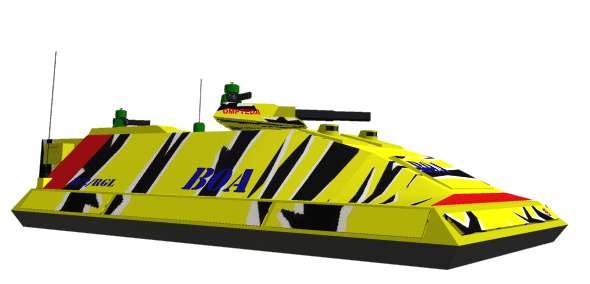
| Above:
Templer of Kampfgruppe Paterson's B Company on Crater
prior to crossing the Line of Departure for an assault on
a Kafer perimeter post Introduction The Templer is the very modern Hover Infantry Fighting Vehicle equipping frontline British armoured infantry battalions and several other nation's contingents in the Commonwealth Expeditionary Forces. It is designed to act not simply as a battle taxi but as a powerful fighting vehicle in its own right, capable of closing with and destroying the enemy with its own weapons as well as its troop complement. Its introduction was marred by several problems and initially troops preferred the older, more reliable and more comfortable Rifleman. However in action against the Kafers the Templer has earned its spurs against its hulking opponents. Narrative The nine Templers accelerated towards the Kafer perimeter post. The rear troop door was already open and the panzergrenadiers out of their safety harnesses ready to disembark immediately. The rooster tail of dust, mixed with a volley of airborne countermeasures, drew the Kafer's attention almost immediately and a pair of missiles leapt away from the ground seeking out the fast moving IFVs. Instantaneously the ground around the Kafer position began to boil as an artillery strike from the landship Titan lashed in. On an easterly ridge three Montgomeries and a further group of Templers appeared and began to add their direct fire into the maelstrom. Major Schmidt swore as the Templer to his left took a hit and swung out of line trailing smoke, slowing fast. The Templer vibrated as the point defence gun started engaging incoming rockets and was joined by the deeper ring of the plasma cannon. He unplugged the data feed into his TISS prior to disembarking with his men. 'Funf hundert, Vier, Drei..' the gunner began to count down to disembarkation. Like the Legion always did they were going in fast and hard, de-bussing only fifty metres from the enemy position. Schmidt scrambled back into the troop compartment where his Company Tac HQ waited crowded by the door. The engine screamed wildly as the Templer slowed. 'Zwei! Eins!' Nose dropping, skirts digging in and pitching the troops towards the bow. They were out before the Templer stopped, the noise of the firing tripled. The depleted line of HIFVs were all firing every weapon they had at frighteningly close targets, panzergrenadiers surging forwards into the shattered alien positions as the Templers began to back away. A rocket exploded off the hull of a retreating vehicle and shrapnel fizzed past Schmidt leaving him unscathed but dropping two of his tac team. By the time he and the MFC had dragged them to the safety of a crater the fighting was almost over and the two platoons were firming up an immediate defence position. Registering targets for the inevitable counter-attack, while two Templers came back in to pick up the wounded. Schmidt was panting hard through his mask as his CSM and reserve platoon arrived. Aggressive assaults were the best way of taking on the Kafers but required excellently trained troops to succeed, Schmidt believed he had the best. Translation from 'Die Königliche Deutsche Legion im der Kafer Krieg ' - Gatow Press, Berlin, 2308. |
| Vickers - British Exospace FV 835 'Templer'
Infantry Fighting Hover Vehicle The design of the Templer grew out of the increasing realisation that conventional hover-mobile APC's were simply not survivable on the modern battlefield. In order to deliver their troops they had to disembark far from the enemy positions, slowing the tempo of the assaults and exposing the infantry to both direct and indirect fires. What was required was a vehicle that could deliver the troops close to enemy position whilst being protected from most man-portable anti-tank systems, light weapons and artillery fire. Bavaria came to the same conclusion as a result of her experience in the Central Asian War, their response was the development of the highly aggressive Stumtaktik concept. For some time the British had an interest in this program, trialing a company group trained and equipped in these techniques. However they eventually came out against adopting it, finding it tactically dangerous against an aware enemy and disliking the cumbersome Battlesuits. Additionally in Bavarian service Sturmtaktik was to be practised only by key units and the British wanted a more general solution. The British had been equipped with the venerable Fusilier ACV-APC since the late 2250's and that vehicle was definitely showing its age. The decision not to purchase the Bavarian LkGfPzTr-VIII in any numbers threw open the need for a replacement. Vickers and British Exospace came up with a high technology demonstrator based on the Craufurd that in trials on Salisbury Plain in 2287 dazzled the General Staff and Minister of Defence into throwing a veritable flood of money into the project. They hoped to field forces based on the Montgomery and Templer AFVs by 2300 and utilise them as the basis of the armoured forces until at least 2320. In the meantime WMV received a contract to rebuild the late model Fusiliers into the Rifleman configuration. Unfortunately Vickers and BEx had not come completely clean about the progress of their demonstrator. In fact several key systems were not yet out of development. However the most serious difficulty was the power struggle waged between Vickers and BEx over the control of the project. Corporate mismanagement was responsible for most of a two year delay to the project's delivery date which did not occur until 2295. Another factor was the rapid escalation of the unit cost of the Templer, and although figures have not been released it is rumoured that the Templer is twice the cost of it nearest rivals. The main body of the Templer is designed to have the same level of armour protection as many early hovertanks, primarily on forward and top arcs and rivals that on tracked infantry carriers. In addition the IFHV is designed with significant levels of internal damage reduction and survivability should the main armour be penetrated. In combat the crew compartment is separated from the troop bay by internal armoured divides. Similarly the placing of the Rolls-Royce Sparrowhawk turbine engine in the bow of the vehicle introduces another level of damage absorption. Lastly the fuel cells in the flanks of the vehicle are in fire proof ceramic honeycombs designed to absorb impacts on the troop bay. This has produced a vehicle which unless hit by the most powerful of armaments will enable its compliment of infantry to escape alive. One of the results of this concentration on protection is that the interior of the vehicle is cramped compared with the older family of British APCs, although it is positively roomy compared with vehicles like the Kangaroo IV. In particular de-bussing from the vehicle is something of a fight when it, and the infantry, are fully loaded. The crew of the standard Templer is ten strong. A driver and gunner are the permanent members of the vehicle crew, with the gunner also doubling as commander when the embarked section is on the ground. The troop compliment is the standard eight man section, the section commander sits in a rear facing seat to the left of the turret basket and has access to the full range of command equipment through a snap down console. The remainder sit in a central row of impact-proof jump seats, four on the right and three on the left. In addition to the passive vehicle protection methods the Templer is equipped with a range of active counter-measures. These include two point defence systems (which are also used as conventional machine guns), a battery of counter-measure dispensers and a number of dedicated EW arrays. The emphasis is to enable the Templers to cross ground as quickly as possible whilst overwhelming enemy defences with a combination of direct fire and countermeasures, suppressing an effective response. The weapons systems of the Templer are impressive compared with other APCs. At the rear of the vehicle is a single vertical launch Sky Streak system with a single re-load. This hypervelocity missile is capable of destroying both the heaviest armoured vehicles in service as well as low flying aircraft. In the off-set remote turret are two main systems, a 51mm MDC and a co-axial 75MW plasma weapon. Normally such a powerful plasma weapon would be the main armament but is used here against infantry and soft-skinned vehicles, modern advanced composite type armour systems have lessened the overall effectiveness of plasma strikes. The rapid fire, highly accurate MDC, often referred to as the '51mm sniper rifle' is used to repeatedly strike targets at long range and smash external features such as weapons and sensors rather than outright destroy hovertanks. It also has a number of special weapons for suppressing enemy infantry positions. Although designed specifically for the purpose of closing on static enemy positions in the most hostile of fighting environments whilst supported by artillery and hovertanks, the Templer has proved a most versatile combat system. Indeed the Templer is virtually capable of going toe-to-toe with the older generation of hovertanks. The vehicle's overall combat power has allowed it to be handled with much more élan and aggression than previous APCs. Two British armoured infantry battalions were the first to take the Templer into combat against the Kafers during the Invasion of Beta Canum-4. They were most commonly used in mobile defence in depth of limited counter-attacks against Kafer assaults. The Templers were used especially to finish off Kafer APC's once the supporting Deathsleds had been killed by a combination of Sky Streak volleys and rapid gunnery from Montgomery HBT. Since then the British have accelerated production of the Templer to its front-line forces and all units on the French Arm are now so equipped. Many Commonwealth forces committed to the Kafer War have equipped with Templers (allegedly with a hefty subsidy) partly for its capabilities but also to ease logistical problems. It is a matter of contention as to what the name of the Templer actually refers to. As a matter of fact it refers to a British post-WW2 General expert in counter-insurgency operations, hence an unusual subject for an armoured infantry vehicle to be named after and not the Knights Templar. Vickers and BEx however, and their joint venture company Templer International PLC utilise a stylised medieval knight in their promotional literature and advertising. So far alongside the UK; Canada, the Netherlands, Wellon, Alicia and New Africa have procured this AFV. Type: British Hover IFV |
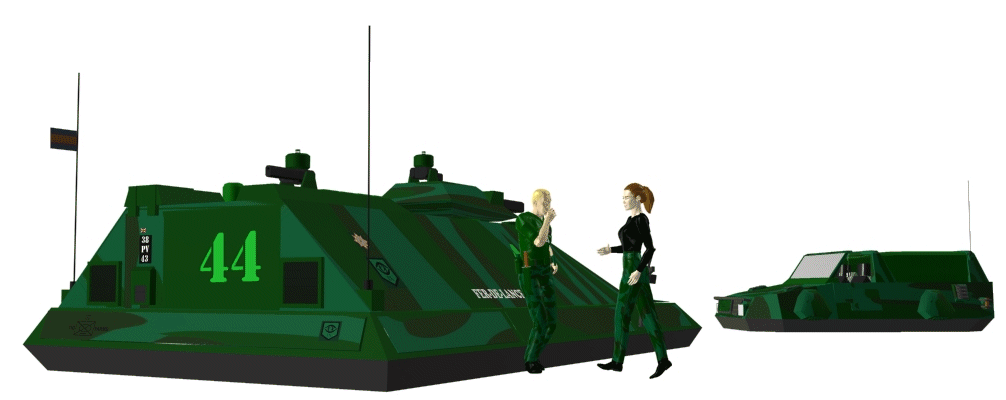
| Above:
Templer belonging to the Int Cell of 1 Irish Guards
Battle Group. Captain Hart (left), the Intelligence
Officer, responsible for the tasking of all the Battle
Group's recce, patrol and drone assets confers with an
Liaison Officer from 3 (NA) Light Division HQ prior to a
tour as QRF Battle Group in K-Zone West.
The Templer is a relatively new vehicle and consequently has only a few specialised variants. Of these only the AT Variant with a distinctively elongated Sky Streak magazine is visually different. Modified Rifleman APCs are normally used within Templer equipped battalions for tasks such as vehicle recovery and mortar carriers. Section Vehicle The Section Vehicle is the standard Templer used and comprises some 90% of the Templer fleet. It is the baseline version of the vehicle described above. This standard vehicle is fully capable of operating as a tactical HQ for platoon and company commanders, consequently it is used by commanders at those levels as well. Command Vehicle The Command Vehicle variant of the vehicle is first found at company level, with one CV attached to each company. It becomes progressively more common further up the chain of command. The CV is equipped with additional communications and expert systems. The CV is responsible for tying the company into the wider Battlegroup net. It also has to control the forward movement of combat supplies and other logistics support to the company. Lastly the CV has systems dedicated to maintaining the basic administration of the unit. At Battlegroup level each CV is dedicated to certain functions, such as intelligence, operations, fire support etc. Forward Observation Vehicle The British try to ensure that each company within a Battlegroup has an attached Forward Observation team from its supporting artillery Battery. To make target acquisition of these important assets difficult for enemy gunners and AFV recognition systems these vehicles are the same as the supported battalion i.e. Montgomeries for armoured units, Templers/Riflemen for infantry. The Templer FOV is externally identical to the Section Vehicle, and includes all the systems of that baseline vehicle. However normally the FOV does not carry a loaded Sky Streak launcher, although Templers FOV's of 79 Medium Regiment, RA did in action on New Africa. Internally the Templer carries the Damocles and CASIS systems and three workstations for the FOO and his team. Anti-Tank The Templer AT is designed as the integral mobile anti-tank capability for the infantry Battlegroup. Instead of the compliment of troops it carries a larger magazine for its Sky Streak launcher carrying six rounds. A further four Sky Streak rounds are carried in the troop bay and can be loaded (with some difficulty) into the magazine internally. In addition to the two vehicle crew a further two soldiers are carried in the troop bay, one of which commands the vehicle. They also have a Enhanced Firing Post system for dismounted action, either firing Green Hunters (six tubes being carried) or remotely commanding the Sky Streaks by FO command wire or radio link. |
| Layout
|
| Weapons Vickers L88A1 51mm Rapid Fire Mass Driver Cannon The L88 was developed as a replacement
for low calibre cannons and medium power plasma guns
normally found on light AFVs. Its role was to be a
multi-purpose one. Capable of destroying light tanks and
APCs, whilst damaging more heavily armoured vehicles or
at least putting off its gunner by destroying sensors and
weapon mounts. The Vickers also has a range of
anti-personnel and anti-material rounds that have proved
very useful in combat.
Quantum Industries LTD L87A2 Heavy Plasma Gun When the Central Asian War broke out, Britain did not field a heavy plasma weapon. It was felt that the weight savings against a medium calibre Mass Driver Cannon for a weapon with less flexibility was a waste. The CAW showed that heavy plasma weapons did provide an extremely useful anti-bunker and anti-light vehicle weapon. Quantum was already producing a 46mm Plasma Cannon for export, and so was asked to adapt one of their weapons for inclusion on the Fusilier replacement. The main adaptations were the adoption of modern fire control equipment, and increased recoil absorption. The weapon entered British service in 2287, 3 years after the initial contract was drawn up. The L87 is used on both the Rifleman and Templer vehicles. On the Templer it acts as a co-axial weapon for the L88 MDC. It is used as a supplementary weapon against APCs as the plasma 'splash' inside such vehicles is devastating. It is also used to engage other targets. In action the L87 has proved to be relatively little used, studies are underway looking into possibly replacing it with an AGL or similar weapon. (Note, I back-engineered the CLP-1A in FF&S, it comes out about right, except the shell is 4.2kg, not 3.5kg. I haven't taken down the shell masses here, but could do to fit). Type: 0.75Mj (75MW)
Vehicle Mounted Plasma Gun Verlet Defender 7.5mm Vehicular Point Defence Chain Gun The Verlet Defender has arisen from a Dutch Army contract in 2285 to upgrade their LkPz-VIII fleet's point defence system. At the same time the British firm Eldon Systems Ltd was looking to provide upgrades for the popular Dragoon and Hussar family of vehicles in service with many colonial militaries. The result was the Verlet Defender that combines a heavy 7.5mm round with a integral Thermal and Millimetre Wavelength Radar seeker unit. The system provides excellent point defence against conventional ATGW and low-V cannon rounds, but is less effective against Hyper Velocity Missiles and high-V rounds. This unit is also highly effective against infantry. In British service the Verlet Defender has been fitted to Montgomery and late model Cavalier Mk.4's HBT. The Dutch have also adopted this system for their Mechanised Brigades, but there has not been as large a take up amidst other users as was expected, a factor in the commercial demise of Eldon Systems in 2295.
BEx Sky Streak AV Missile The Sky Streak was originally conceived as a low level air defence missile, but was adapted to anti-armour use after French forces engaged the Manchurian Type 27 in the Central Asian War. The changes were to the warhead package (to a tungsten penetrator suspended in liquid teflon) and the targeting software. The guidance system has 3 available modes, laser designation (gunner roll), optical target lock (automatic, following gunner lock on) or self targeting (automatic). The missiles terminal velocity is in excess of Mach 12, it does however, take a significant time to boost up to it's attack velocity, thus the minimum range of this weapon is 1000m. Attacks below this range are possible, but at a reduced damage (reduce damage by 10% for each 100m below 1000m).
|
| Colour
Plates PLATE 1 |
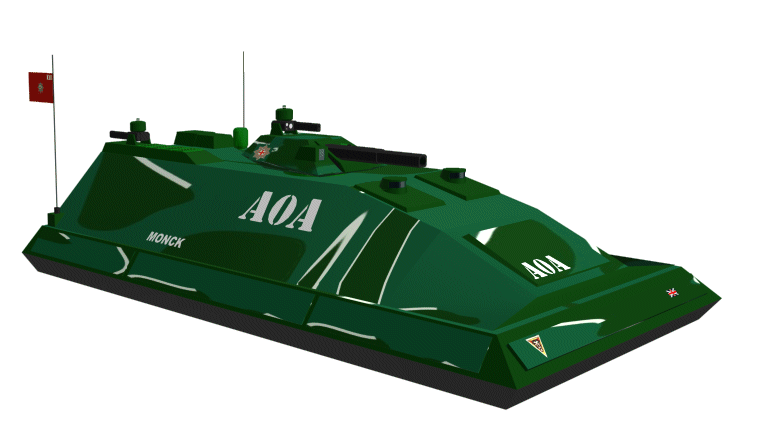
| Templer, No. 9 Company, 3rd
Battalion, The Coldstream Guards, 79th Armoured Brigade
Group Lower Dannon Valley, New Africa, Beta Canum Venaticorum - 4, 15th February 2302 The 3rd Coldstream Guards were a part of 79 Armd Bde which was the only pre-Invasion regular British armoured force on the French Arm. When the invasion occurred the brigade was moved from its normal garrison locations on Joi to Beta Canum to await further developments. Unfortunately the Kafers were several jumps ahead of human forces and launched an assault on Beta Canum-4. 79 Armd Bde was reinforced with elements from the Light Division and NADF and operated as the New Africa Manoeuvre Force. The NAMF was largely responsible for the British colony avoiding the fate of its French and German counterparts. In a weeks long fighting retreat known as the Battle of the Grasslands they drew the sting of the Kafer forces, but at a heavy cost. The Templer pictured here is shown at a pivotal point in the battle when the 3rd Coldstream Battlegroup was seemingly forced out of the Lower Dannon Valley, instead the pursuing Kafers were drawn onto a nuclear demolition device laid by 13 Commando. The 3rd Coldstream used a pattern typical to NAMF units and other British forces that fought on Beta Canum during the Invasion and Occupation, but not used by units involved in the Liberation. It carries the brigade 'bull's head' insignia (A), regimental Star of the Order of the Garter (B) and the name 'Monck', the founder of the regiment back in 1650. The A0A callsign show this to be the OC's vehicle. A battalion standard (C) is also flown on one of the radio antennas.
PLATE 2 |
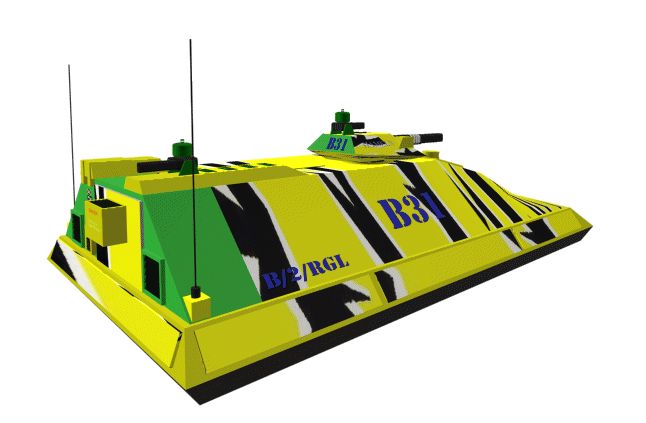
| Templer, B Company, 1st RGL Line
Battalion - Kampfgruppe Paterson,
Crater Defence Force Dayside, Crater, Henry's Star 1st December 2301 KG Paterson is the oldest of the Royal German Legion units and the most experienced. After participating in the 3rd (and final) Liberation of Beta Canum it was augmented with CSS assets from its parent brigade and shipped off to Crater where Kafer Remnants operating from the Dayside began to make a nuisance of themselves raiding human settlements. The Kampfgruppe was the only armoured force operating on Crater and was very much in demand. It fell upon the unit to destroy the Remnant's armoured capability, a task at which they proved remarkably adept. They were then called upon to take in the reduction of Kafer stongholds which caused the majority of their casualties. This Templer is shown during the Storming of Eisen's Tower, a former mine complex and the last defence before the infamous Krak Des Chevaliers. B Company had been involved in the clearing of perimeter positions in conjunction with the ACV carrier HMLS Titan ranging deep into the enemies rear areas. The Kampfgruppe is painted with the unit's distinctive high contrast pattern which was a trend setter for subsequent Dayside patterns. The Templer carries two tactical insignia, its callsign and 'chalk' mark (A). The only significant non-tactical insignia on this typically austere RGL vehicle is the legend 'Hameln' (B) a major battle-honour of the 2nd German Legion of the Twilight Era. The vehicle carries 4 kill rings on the 51mm barrel. The green markings denote which platoon the vehicle belongs to, enabling easy recognition during assaults. Notable is the supercharger on the back of the troop door which provides the crew with breathable atmosphere.
PLATE 3 |
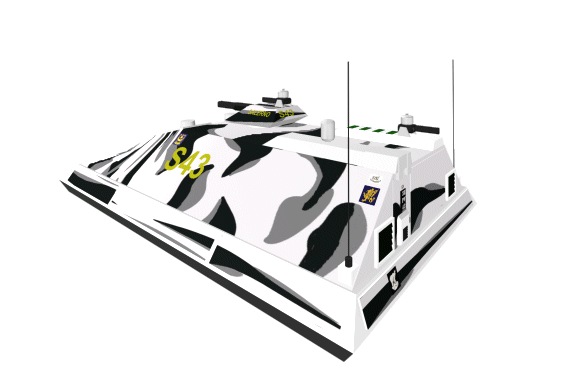
| Templer AT, Support Company, 2nd
(Royal Hampshire and Wessex) Battalion, The Royal Wessex
Regiment, 49th Independent Armoured Group, 6th (South
Atlantic) Division British Territories, Antarctica, Earth, 16th May, 2298 This Anti-Tank Variant belongs to the British Army's only specialised arctic (or rather Antarctic) armoured infantry battalion. Alongside the 5th (Royal Inniskilling) Dragoon Guards they compose the 49th Independent Armoured Group which protects the British Antarctic Territories from Argentine incursion. Although stable at the moment the border can be often compromised by Argentine Marines, and the 49th called upon to respond. Although normally cat and mouse affairs they have often rapidly escalated into bloody, if short lived conflict. As a result 49th IAG is at the front of the queue for modern equipment. 2 R WESSEX is recruited from the south coast of England, most heavily from the Metroplex that includes the cities of Portsmouth and Southampton. Consequently most of its soldiers are supporters of one or other of these cities football team, and this vehicle carries the shield of Portsmouth FC (A). A more nationalistic addition is the small English flag and the motto, 'These Colours Don't Run' (B). The battalion uses the 'arctic tiger' camo scheme common to the 49th alone, amongst the largely composite 6th Division. The vehicle carries numerous other insignia, including the name Salerno (C) Wessex Wyvern and the old Hampshire Regiment tiger (D). The 49th's Polar Bear insignia (E) and its Butcher Bear nickname (revived by the press after a bloody raid into Argentine territory in 2245) are 'borrowed' from the ancient territorial 49th (West Riding) Division (which has recently been reformed and now uses the Yorkshire rose). 2 R WESSEX has been serving with the 49th since late 2299 and is looking forward to rotating back to the UK. It has sustained some 35 casualties on operations since it arrived.
PLATE 4 |
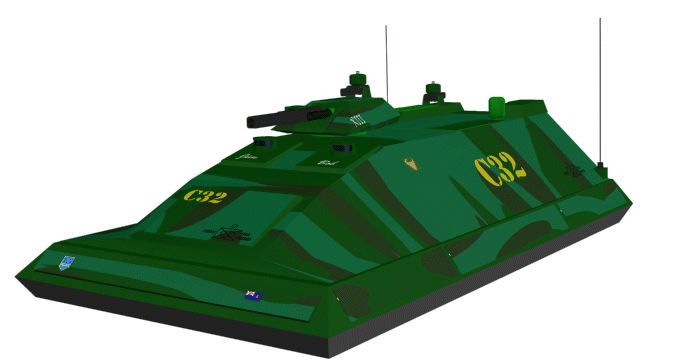
| Templer, C Company, 1st Battalion,
The Mavericks (New Middlesex Irish), 1 New African
Armoured Brigade, 11th (Commonwealth) Armoured Division New Aldershot, New Africa, Beta Canum Venaticorum - 4, 23rd March 2302 This Templer is shown shortly after the activation of the New African Armoured Brigade. The brigade was formed along the lines of a standard British armoured brigade and equipped with the most modern equipment available. It took some six months to bring up to the requisite standard with troops being specially trained by CEF training cadres. The brigade has been much feted in the vociferous New African press as being a key element in the future defence of the colony. Consequently there has been much rivalry between the brigade and the New African Light Division which has been fighting in the K-Zone for the last 6 months. The Mavericks were formed when No.2 Volunteer Company of the 1st Battalion, New Africa Regiment was expanded when Kimanjano was invaded. The resulting unit was dubbed the 3/1st NAR an took on the New Middlesex Irish identity of the Volunteer Company. However the Kafer bombardment of New Middlesex badly disrupted the forming battalion. A kernel of the unit survived to take on the Kafers who occupied the capital when they failed to take all of the colony. These fighters absorbed other units and volunteers and under the inspired, sometimes manic leadership of Major Ken Fitzgerald became the main force resisting the occupation. Fitzgerald had a complicated relationship with General Frederickson, often refusing his authority and lambasting him for not committing regular troops to the city. Their name came from an overheard comment between Frederickson and his ADC. The Mavericks played a key role in the eventual liberation of New Middlesex and were swiftly reformed with volunteers aiding the military effort across Beta Canum. On their return the Mavericks were chosen to form one of the battalions of the planned armoured brigade, and reformed again with unsuitable personnel weeded out. (Fitzgerald was promoted sideways to form and command the Mavericks' volunteer battalions.) It has taken no little time for the veteran street fighters to start to take on board the skills required for an armoured infantry battalion and an influx of young National Service soldiers has proved beneficial. This Templer carries small markings, New African flags, Maverick badge (A) and a new style tactical insignia (B) brought in to replace the cruder 'chalk' marks often seen on vehicles in 2302. The vehicle carries a full colour Commonwealth Armoured Division shield (C) on the bow. More interesting is the chalked 'XIII' (D) on the side of the turret. This indicates support for the Le Comité Treize an organisation formed by veterans of the New African Legion and the Commandos, especially the controversial 13 Commando, from across Beta Canum. This secret organisation has been behind the recent assassination of a French colonial administrator alleged to be a Quisling. The colonial powers are very worried by the level of support for this group, especially in the NADF.
|